Description
 The mourning dove is 9-13 inches in length with a wingspan of
15-18 inches. It has a grayish-brown body; a long, pointed tail bordered in white; a small, round head; a small, thin, black bill; and small pink legs and feet. It has black spots on its wings and a black spot under its eye. It has brown eyes surrounded by a blue circle of skin. Males and females look alike, but the female is slightly smaller and duller in color. The mourning dove is 9-13 inches in length with a wingspan of
15-18 inches. It has a grayish-brown body; a long, pointed tail bordered in white; a small, round head; a small, thin, black bill; and small pink legs and feet. It has black spots on its wings and a black spot under its eye. It has brown eyes surrounded by a blue circle of skin. Males and females look alike, but the female is slightly smaller and duller in color.
Range
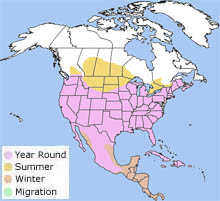 The mourning dove breeds
from southern Canada south through most of the United States.
Only the northern most populations migrate in the fall. The mourning dove is also found in Central America and the Caribbean. The mourning dove breeds
from southern Canada south through most of the United States.
Only the northern most populations migrate in the fall. The mourning dove is also found in Central America and the Caribbean.
Habitat
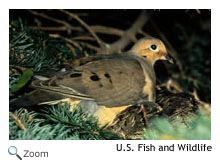 The mourning dove is found in
variety of open habitats including farms, parks, woods, deserts, forest edges, cities, and suburbs. The mourning dove is found in
variety of open habitats including farms, parks, woods, deserts, forest edges, cities, and suburbs.
|
|
Diet
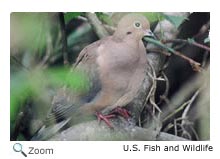 The mourning dove
forages on the ground for seeds. It feeds in pairs or flocks. It swallows fine gravel to help it digest hard seeds! It is a frequent visitor to bird feeders. The mourning dove
forages on the ground for seeds. It feeds in pairs or flocks. It swallows fine gravel to help it digest hard seeds! It is a frequent visitor to bird feeders.
Life Cycle
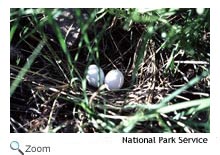 The male collects materials for the nest, and the female weaves the materials into a platform of grass, pine needles, and twigs in a tree or shrub.
Both the male and the female incubate the eggs for 14 days. The male collects materials for the nest, and the female weaves the materials into a platform of grass, pine needles, and twigs in a tree or shrub.
Both the male and the female incubate the eggs for 14 days.
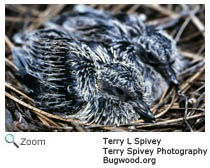 Both parents feed the chicks, or squabs, "pigeon milk." Pigeon milk is a
a mixture of water, fat, minerals, and protein that the male and female mourning dove produce in their crop. Their crop is a
sac at the bottom of their esophagus.
Pigeon milk is also called crop milk. Both parents feed the chicks, or squabs, "pigeon milk." Pigeon milk is a
a mixture of water, fat, minerals, and protein that the male and female mourning dove produce in their crop. Their crop is a
sac at the bottom of their esophagus.
Pigeon milk is also called crop milk.
The chicks fledge when they are 2 weeks old, but they stay near their parents for 1-2 weeks and continue to be fed by them. In warm areas, the female mourning dove may have as many as six broods a year.
Behavior
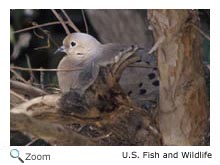 The mourning dove is named for its haunting and sad cooing sound. Its call is sometimes mistaken for the call of an owl. When the mourning doves flies, its wings make a whistling sound. The mourning dove is named for its haunting and sad cooing sound. Its call is sometimes mistaken for the call of an owl. When the mourning doves flies, its wings make a whistling sound.
|

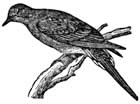

 The mourning dove breeds
from southern Canada south through most of the United States.
Only the northern most populations
The mourning dove breeds
from southern Canada south through most of the United States.
Only the northern most populations 



